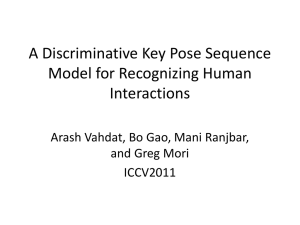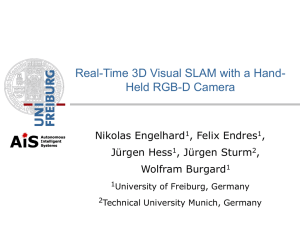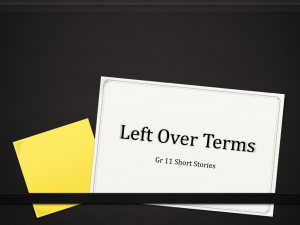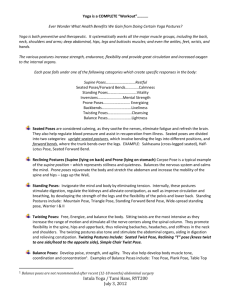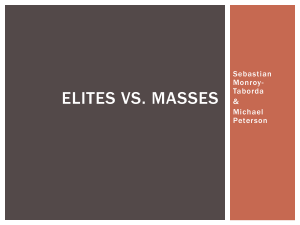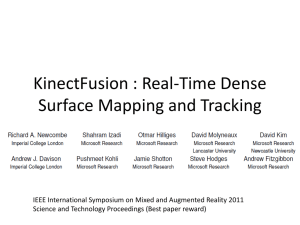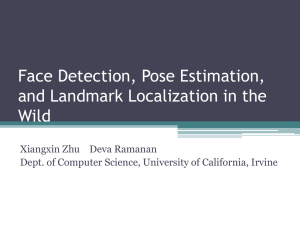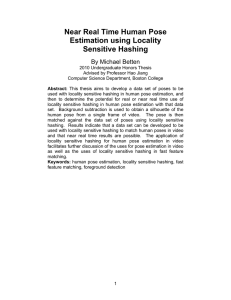Slide - Microsoft Research
advertisement
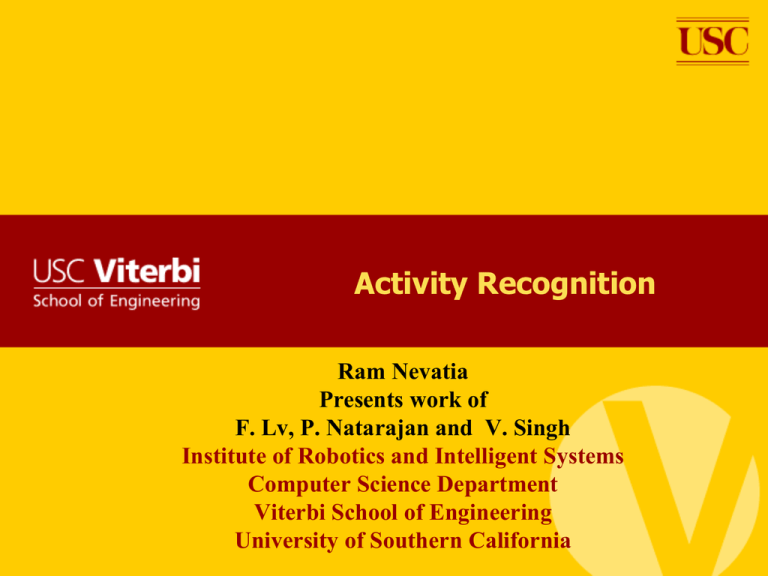
Activity Recognition Ram Nevatia Presents work of F. Lv, P. Natarajan and V. Singh Institute of Robotics and Intelligent Systems Computer Science Department Viterbi School of Engineering University of Southern California Activity Recognition: Motivation • Is the key content of a video (along with scene description) • Useful for • • • • Monitoring (alerts) Indexing (forensic, deep analysis, entertainment…) HCI .. Issues in Activity Recognition • Inherent ambiguities of 2-D videos • Variations in image/video appearance due to changes in viewpoint, illumination, clothing (texture)…. • Variations in style: different actors or even the same actor at different times • Reliable detection and tracking of objects, especially those directly involved in activities • Temporal segmentation • Most work assumes single activity in a given clip • “Recognition” of novel events Possible Approaches • Match video signals directly • Dynamic time warping • Extract spatio-temporal features, classify based on them • Bag of words, histograms, “clouds”… • Work of Laptev et al • Most earlier work assumes action segmentation (detection vs classification) • Andrew’s talk on use of localization and tracking • Structural Approach • Based on detection of objects, their tracks and relationships • Requires ability to perform above operations Event Hierarchy • Composite Events • Compositions of other, simpler events. • Composition is usually, but not necessarily, a sequence operation, e.g. getting out of a car, opening a door and entering a building. • Form a natural hierarchy (or lattice) • Primitive events: those we choose not to decompose, e.g. walking • Recognized directly from observations, • Graphical models, such as HMMs and CRFs are natural tools for recognition of composite events. Key Ideas – Only need a few primitive actions in any domain. – Sign Language: Moves and Holds. – Human Pose Articulation: Rotate, Flex and Pause. – Rigid Objects (cars, people): Translate, Rotate, Scale. – Can be represented symbolically using formal rules. – Composite Actions can be represented as combinations of the primitive actions. – Handle uncertainty and error in video by mapping rules to a Graphical Models. – HMM. – DBN. – CRF. Graphical Models • A network, normally used to represent temporal evolution of a state • Next state depends only on previous state; observation depends only on current state, single state variable • Typical task is to estimate most likely state sequence given an observation sequence- Viterbi algorithm An HMM A CRF Mid vs Near Range • Mid-range • Limbs of human body, particularly the arms, are not distinguishable • Common approach is to detect and track moving objects and make inferences based on trajectories • Near-range • Hands/arms are visible; activities are defined by pose transitions, not just the position transitions • Pose tracking is difficult; top-down methods are commonly used Mid-Range Example • • • • Example of abandoned luggage detection Based on trajectory analysis and simple object detection/recognition Uses a simple Bayesian classifier and logical reasoning about order of sub-events Tested on PETS, ETISEO and TRECVID data Top-Down Approaches • Bottom-up methods remain slow, are not robust; many methods are based on use of multiple video streams • An alternative is of top-down approaches where processing is driven by event models • Simultaneous Tracking and Action Recognition (STAR) • In analogy with SLAM in robotics • Provides action segmentation, in addition to recogntion • Closed-world assumption • Current work limited to single actor actions Activity Recognition w/o Tracking … Input sequence Action segments check watch … punch … kick … pick up throw + 3D body pose … … … … Difficulties • Viewpoint change & pose ambiguity (with a single camera view) • Spatial and temporal variations (style, speed) Key Poses and Action Nets • Key poses are determined from MoCap data by an automatic method that computes large changes in energy; key poses may be shared among different actions Experiments: Training Set 15 action models 177 key poses 6372 nodes in Action Net Action Net: Apply constraints 0o 10o … Experiments: Test Set 50 clips, average length 1165 frames 5 viewpoints 10 actors (5 men, 5 women) A Video Result original frame extracted blob & ground truth without action net with action net Working with Natural Environments • Reduce reliance on good foreground segmentation • Key poses may not be discriminative enough w/o accurate segmentation; include models for motion between key poses • More general graphical models that include • • • • Hierarchy Transition probabilities may depend on observations Observations may depend on multiple states Duration models (HMMs imply an exponential decay) • Remove need for MoCap data to acquire models Composite Event Representation CE: Sequence(P1,P2) P1: Rotate( Right, Arm, 90o,z-axis) P2: Rotate( Right, Arm, 90o,-z-axis) Learning Event Models Primitive Event P1 Primitive Event P2 Composite Event = Sequence(P1,P2) Dynamic Bayesian Action Network – Map action models to a Dynamic Bayesian Network – Decompose a composite action into a sequence of primitive actions – Each primitive is expressed in a function form fpe(s,s’,N). – Maps current state s to next state s’ given parameters N. – Assume a known, finite set of functions f for primitives. Inference Overview • Given a video, obtain initial state distribution with start key pose for all composite actions • For each current state: • Predict the primitive based on the current duration • Predict a 3D pose given the primitive and current duration • Collect the observation potential of the pose using foreground overlap and difference image • Obtain the best state sequence using dynamic programming (Viterbi Algorithm) • Features used to match models with observations • If “foreground” can be extracted reliably, then we can use blob shape properties; otherwise, use edge and motion flow matching Pose Tracking & Action Recognition • Obtain state distributions by matching poses sampled from action models • Infer the action by finding the max likelihood state sequence, Inference Algorithm Observations • Foreground overlap with full body model, • Difference Image overlap with body parts in action • Grid-of-centroids to match foreground blob with pose Results • From CVPR08 paper Action Learning • Involves two problems • Model Learning: Learning parameters N in the primitive event definition fpe(s,s’,N). – Key Pose Annotation and Lifting. – Pose Interpolation • Feature Weight Learning: Learning the weights wk of the different potentials. KeyPose Annotation and 3D Lifting Pose Interpolation • All limb motions can be expressed in terms of Rotate(part,axis,q). • We need to learn axis and q. • Simple to do given the start and end joints of part. Feature Weight Learning • Feature weight estimation Latent State Voted Percepton as minimization of a loglikelihood error function. • Learn the weights using Voted Perceptron Algorithm • Requires fully labeled training data -> not available. • We propose an extension to deal with partial annotations. Experiments • Tested method on 3 datasets • Weizmann dataset • Gesture set with arm gestures • Grocery Store set with full body actions Dataset Train:Test Action Recognition 2D Tracking Ratio (% accuracy) (% error) Speed (fps) Weizmann 3:6 99.5 -- -- Gesture 3:5 90.18 5.25 8 Grocery Store 1:7 100.0 11.88 1.6 Weizmann Dataset • Popular dataset for action recognition • 10 full body actions from 9 actors • Each video has multiple instance of one action Train:Test Recognition Accuracy Jhuang et al [9] 6:3 98.8 Space-Time Shapes [6] 8:1 100.0 Fathi Et al [5] 8:1 100.0 Sun et al [20] 3:6 87.3 DBAN 1:8 96.7 DBAN 3:6 99.5 Gesture Dataset • 5 instances of 12 gestures from 8 actors. • Indoor lab setting. • 500 instances of all actions. • 852x480 pixel resolution, person height: 200-250 pix. Grocery Store Dataset • Videos of 3 actions collected from a static camera. • 16 videos from 8 actors, performed at pan angles. • Actor height varies from 200-375 pixels, in 852x480 resolution videos. Incorporating Better Descriptors • • Previous work based on weak lower-level analysis We can also evaluate 2D part models Dynamic Bayesian Action Network with Part Model Experiments • • Hand gesture dataset in an Indoor lab • 5 instances of 12 gestures from 8 actors, total of 500 action segments Evaluation metrics • Recognition rate over all action segments • 2D pose tracking as average 2D part accuracy over 48 randomly selected instances Dataset Train:Test Ratio Recognition (% accuracy) 2D Tracking (% accuracy) DBAN-FGM 1:7 78.6 75.67 (89.94) DBAN-Parts 1:7 84.52 91.76 (92.66) Summary and Conclusions • Structural approach to activity recognition offers many attractions and challenges • Results are descriptive but detecting and tracking objects is challenging • Hierarchical representation is natural and can be used to reduce complexity • Good bottom-up analysis remains a key to improved robustness • Concept of “novel” or “anomalous” events remains difficult to formalize
